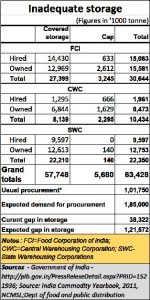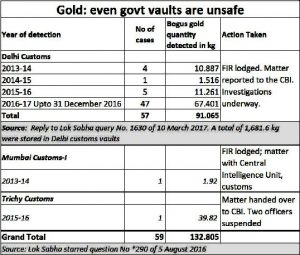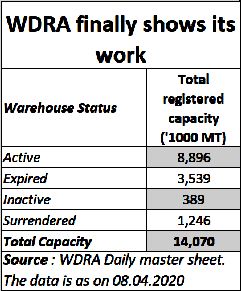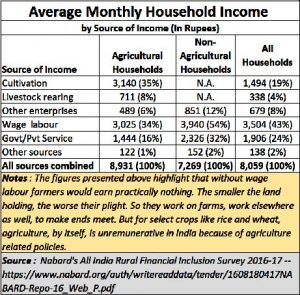A modified version appeared in https://www.moneylife.in/article/the-fight-is-no-longer-between-the-good-and-the-bad-but-between-the-corrupt-and-the-rapacious/62370.html
The farmer agitation: The fight is no longer between good and evil, but between the corrupt and the rapacious
RN Bhaskar — 15 December 2020
The farmer’s agitation has thrown up some rather perplexing questions. Unfortunately, till now, few have dared articulate them. Politicians do not want to speak about such things because most of them have themselves been beneficiaries of corruption. So, when farmer leaders are accused of corruption, they cannot defend themselves. But they cannot submit to a more dangerous game being played.
 The truth is a lot more complex. There is growing discomfort that few are willing to talk about the centre’s culpability.
The truth is a lot more complex. There is growing discomfort that few are willing to talk about the centre’s culpability.
True, APMCs are corrupt. But so is the Food Corporation of India (FCI) — several times more. Yet FCI is allowed to procure more grain than even the storage capacity in India (see chart).
APMCs are managed by states. FCI is managed by the Centre.
The centre seeks to abolish state corruption. But it permits central corruption.
The pot and the kettle
The entire game appears to be one in which the centre is trying to stop state political sources of finance, using corruption as an excuse.
It is India’s Bo Xilai moment. That is how many in China perceive the moves against corruption. They recall how the China premier Xi Jinping managed to remove Bo Xilai — one of his most formidable political contenders — by slapping corruption charges against him.
Like in China, so in India. As the old saying goes, in the public bath, everyone is naked (hamam mein sab nange hain). It is extremely easy for a powerful politician to accuse another of corruption, without actually addressing the source of corruption.
Look at how not a single IAS officer or head of a public sector bank has been prosecuted, even though the heads of ICICI, PMC and YES Bank have been. The scams of the PSBs are many times larger than those of all banks put together. And it has continued to increase PMC and Yes Bank were known to be source of funds for the opposition.
 Again, consider how, Kerala’s politicians are being hounded for the gold smuggling involving 25 kg, while 100 kg stolen from the CBI vaults is quietly relegated to the inside pages. This is despite such thefts happening, repeatedly, from central government vaults (see chart). The 100 kg theft is the largest booty to date. This theft could have been avoided if the government were to keep just one vault and a central registry under the RBI or any other designated gold regulator (http://www.asiaconverge.com/2020/10/gold-smuggling-ii-a-cleanup-is-urgently-needed/). But that is not being done.
Again, consider how, Kerala’s politicians are being hounded for the gold smuggling involving 25 kg, while 100 kg stolen from the CBI vaults is quietly relegated to the inside pages. This is despite such thefts happening, repeatedly, from central government vaults (see chart). The 100 kg theft is the largest booty to date. This theft could have been avoided if the government were to keep just one vault and a central registry under the RBI or any other designated gold regulator (http://www.asiaconverge.com/2020/10/gold-smuggling-ii-a-cleanup-is-urgently-needed/). But that is not being done.
The more one looks at developments, the more is one convinced that almost all raids and seizures that have taken place have been focused on individuals and entities known to be funding the opposition.
Opposition states are against the contentious farm legislation also because, deftly, the centre has tried to convert a state subject into a central domain. Worse, it sought to keep disputes related to agriculture outside the domain of courts, as pointed out brilliantly by noted journalist P. Sainath (https://www.youtube.com/watch?v=rXzLrRAdXIM).
With opposition leaders incensed, the farmers livid and the past promises of the government ringing hollow, expect this agitation to blow up, big-time. Suddenly, non-BJP (and even some BJP ruled states) have found an issue around which they can rally.
Why exempt the FCI?
To understand this, it is necessary to look at the three pieces of legislation relating to agriculture which the farmers want repealed (http://www.asiaconverge.com/2020/09/two-cheers-not-three-for-the-agri-bills/). They talk about the need for farmers’ produce being sold through commodity markets, and not through APMCs. They talk about contract farming, but don’t permit farmers to give their land on lease to another farmer or corporate. The only part of the legislations that appears to be without major flaws is the one which allows for the free movement of farm produce across the country.
First take the bit about commodity markets. If all agricultural produce must be sold through commodity markets, why was the law not extended to cover the Food Corporation of India (FCI)? It is the largest procurement agency in the country. So, if selling to the APMCs is bad, why is sale to the FCI good?
And why is it that even after six years in power, the warehouse storage for grains continues to remain inadequate, even while procurement continues to soar (see table). Once again, if you analyse this situation, you find that (http://www.asiaconverge.com/2018/03/record-food-grain-production-but-value-destruction-as-well/) there is a close linkage between corruption and the penchant for procuring more grain than the warehouses can store.
The answer can be found in the Supreme Court’s ire in 2010 when it learnt that huge quantities of grain were lying in the open, exposed to the elements and pests. It ordered that all grain that could not be stored should be given free of cost to the poor. Sharad Pawar, the Union agriculture minister then, informed the Supreme Court that he would try respect its orders, but found reasons not to distribute the grain to the poor. It gradually seeped in that the grain was of such abysmal quality that the poor would have revolted, and the malpractices of the FCI would come to light.
According to well informed people in the government, the FCI often purchases second (or even third) rate grain from farmers at first grade prices. Most of the beneficiaries are large farmers, often in Punjab, Haryana and Western Uttar Pradesh, though well-connected farmers in other states also benefit. Small farmers are often ignored, leaving them to sell at distressed prices, despite the MSP.
The difference between paid price and the price-that-ought-to-have-been is shared by the farmer, FCI officials and other politicians. The pickings are large. At other times, the FCI is persuaded to revise the FAQ (fair and acceptable quality) for grains, and then justify the procurement of all rain damaged crop. This crop is then sent to flour mills, so that the bad quality grain gets mixed up with good quality grain. As it happens, most of the flour mill owners are also farmer-politicians. They know the quality of grain that goes into the flour mill and ask for a subsidy from the government. They get the additional money too. Thus, there are multiple benefits when it comes to FCI’s procurement — big farmers, central and state government officials and politicians are all major beneficiaries.
 By abolishing APMCs the government cuts off the incomes of state politicians but keeps intact the incomes and benefits accruing from the centre as largesse to those who play ball with it. It strengthens the clout of the centre even while weaking the financing capability of the states. Both sides are corrupt. It is only a story of the pot and the pan.
By abolishing APMCs the government cuts off the incomes of state politicians but keeps intact the incomes and benefits accruing from the centre as largesse to those who play ball with it. It strengthens the clout of the centre even while weaking the financing capability of the states. Both sides are corrupt. It is only a story of the pot and the pan.
What about the WDRA?
There is another angle to this. In 2007, the Union government tabled the Warehousing (Development & Regulation) Act (WDRA). Then it was forgotten because neither the FCI, nor the state governments wanted it.
Then, possibly as a reaction to the Supreme Court’s harsh strictures against the government’s ability to provide storage for grain, the files were dusted and re-tabled and the WDRA got enacted on 26 October 2010 vide Government of India Gazette Notification dated 26th October 2010.
The WDRA is a great concept because it is a Statutory Authority under the Department of Food and Public Distribution. It provides for the development and regulation of warehouses, the negotiability of warehouse receipts, and the promotion of orderly growth of the warehousing business in the country. The mission of the Authority is to establish a Negotiable Warehouse Receipt (NWR).
Despite over a dozen emails to the WDRA over the past six years requesting for the status of warehousing under its ambit, this organisation has chosen to maintain a studied silence. Finally, a document of the WDRA emerged in one of the NCDEX annual reports and that is where one gets the information that it has a cumulative capacity at 14.1 million tonnes (see table).
Now compare this number with the 63.4 million tonne storage that already exists with the FCI, CWC and the SWCs. Logic would demand that the centre introduces a law to amalgamate all the warehouses under the WDRA. But it chooses not to do so, and attacks only the APMCs.
Logically, again, the government should be asking the FCI to procure grain for the public distribution shops (PDS) from commodity markets. Let the farmers sell to farmer producer organisations (FPOs) or to WDRA storage units. There, qualified assayers give a receipt for the quality and the quantity of grain given by the farmer. If the quantity is too small, the FPOs act as aggregators. The farmer, with his dematerialised receipts can encash the negotiable receipt with any bank on the basis of current prices on the commodity markets, or sell in future markets, or let the grain lie with the warehouses till he is ready. He can sell part of the grain stored, or the entire lot. The responsibility of keeping the grain intact is that of the warehouse.
That would have cleaned up agriculture. With the volumes of rice and wheat, the commodity markets and the warehouses would have got more business, and there would have been a seamless approach to price discovery.
If the government wants to offer an MSP (not just for rice and wheat, please), it can ask the FCI to purchase the grain through commodity markets at the support prices. That will ensure that traders are also compelled to pay the same prices.
Today, the FCI collects grain only from well connected farmers, leaving smaller farmers to sell at distress prices. That distress would have gone away had the WDRA been given teeth and the warehouses of all government agencies amalgamated under the WDRA.
Clearly, farmer prosperity is not the key issue that the government seeks through the three controversial legislations.
There is no denying that the farmer is distressed. Just look at the data provided by Nabard. It shows that farmers earn as much from daily labour as they do from cultivation. By itself cultivation does not sustain the family.
But observe the figures closely. Livestock gets him only Rs.711 a month. This is absurd. If there is a good cooperative, a farmer should be able to earn at least Rs.100 by way of profit (income less expenses) per cattle per day for 300 days a year. That means that each cattle head should be giving the farmer Rs.3,000 each month.
That he does not get this amount is because the government has not made cooperatives compulsory. UP which is the largest milk producing state does not encourage cooperatives. It pays its farmers Rs.14-18 per litre when cooperatives pay upwards of Rs.26 a litre. Since buffalo’s milk has more fat content, each buffalo can fetch around Rs.50-60 per day. The bank on cattle slaughter makes things more difficult for farmers because he now cannot even get the Rs.20,000 per cattle head he used to get when it stopped giving milk.
UP is a BJP ruled state. Why has it not promoted farmer welfare there? At Rs.14-18 the farmer makes profits of just Rs.2-6 per litre. At Rs.26 he would make another Rs.8 per litre. The farmer would have quadrupled his income.
That is why the sanctity of doubling farm incomes begins to ring hollow.
The three farm legislations are weapons of political marginalisation of opposition states. They are not for farmer empowerment, or for helping agriculture. Some sections may benefit. But not the entire farming community. And not agriculture.
Clearly, if the government is serious about improving the lot of farmers, and of making agriculture healthier, begin with milk cooperatives in Uttar Pradesh, and compelling FCI to purchase from commodity markets first. The rest can follow later.











































COMMENTS